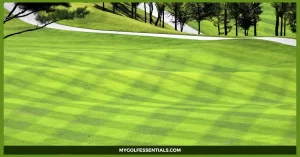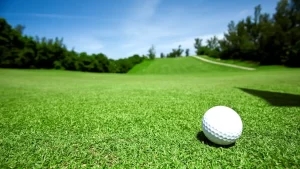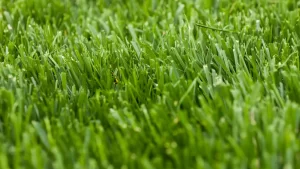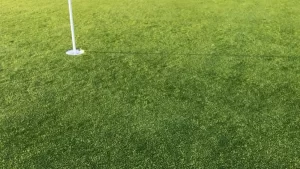Golf Course Grass: Complete Guide

Every decision must be informed to keep your golf course looking its best. That includes selecting the ideal type of grass for each particular area. By knowing the pros and cons of each kind, you can determine which will offer the best mix of aesthetics, maintenance difficulty, wearability, cost, and disease resistance.
Without further ado, let’s jump right in and explore golf course grass types available today!
Overview of Golf Course Grass
Golf course grass is one of the most important aspects of creating a beautiful, playable golf course. The type and quality of the turf that covers golf courses can make or break a golfer’s experience, so courses need to select the right kind of grass to meet their specific needs.
Warm season grass is used on golf courses, offering different characteristics and advantages. The most common types of grass used on golf courses are cool-season grasses (such as bentgrass, fescue grass, and bluegrass), warm season grasses, and specialty grasses (such as Zoysia).
Different Types of Grass Used on Golf Courses

Golf course grass is an essential element of the game. With over 34,000 golf courses worldwide, many types of grass are used to create fairways and greens that accommodate various climates and soils. Each grass type offers unique benefits, such as durability, water retention, disease resistance, and overall playability.
Bermuda

Bermuda grass is one of the most popular types of grass for golf courses due to its high wear tolerance and quick recovery time. It typically grows in warm climates and can withstand extreme temperatures, making it an ideal option for courses near the equator.
Bermuda grass’s rugose, leafy texture allows for a more consistent ball roll than other grass varieties, making it a preferred choice for fairways and putting greens. In addition, Bermuda grass is quite durable and can resist wear from golf carts and foot traffic.
Most Bermuda-type grasses can withstand drought due to their ability to photosynthesize with less water than other types of turfgrass. Most courses that use this type of grass will also provide supplemental irrigation to keep the grass healthy and green during droughts.
In addition, Bermuda grass can tolerate salt damage better than other types of turfgrass, making it suitable for courses near coastal or heavily-salted regions.
Bentgrass
Bentgrass is a grass commonly used on golf courses, especially in cooler climates. It has a fine-textured, dense turf which makes it ideal for creating smooth and consistent putting surfaces.
It also provides excellent ball roll and can be mowed to very low heights – making it an ideal choice for golf greens. Bentgrass grows best in regions with cool temperatures and plenty of moisture, making it a popular choice for courses in the northern United States and Canada.
Bentgrass is known for its excellent wear resistance and recovery abilities. It can withstand heavy foot traffic from golf carts and regular mowing and has an incredibly low thatch layer which helps prevent damage from disease or insects. In addition, Bentgrass has excellent drought tolerance and can survive in warmer climates with reduced watering.
Fescue

Fescue is grass commonly used on golf courses in cooler climates. It has a coarse texture, deep root system, and wear tolerance, making it ideal for fairways and roughs. Fescue grows best in regions with cool temperatures and frequent rainfall, making it the go-to choice for many northern American courses.
Fescue is known for its excellent wear resistance and recovery abilities. It can withstand heavy foot traffic from golf carts and regular mowing, making it an ideal choice for busy courses. In addition, Fescue has excellent drought tolerance, making it well-suited for warmer regions. This type of grass also thrives in cooler temperatures, meaning golfers can expect a good ball roll and consistent putting surfaces during the morning hours.
Zoysia
Zoysia grass is a type of turfgrass that has become increasingly popular on golf courses due to its hardiness and low maintenance requirements. It grows best in warm climates, making it an ideal choice for courses in the southern United States and worldwide. Zoysia grass has a coarse texture and fine blades, giving it excellent wear tolerance and recovery abilities—a big advantage for courses with heavy traffic.
Zoysia grass’s dense and deep roots system makes it highly resistant to drought, disease, insects, and other environmental stressors. This type of grass is also known for its low thatch layer, which helps protect the turf from damage due to regular mowing and foot traffic. Additionally, the leafy texture of Zoysia grass provides a smooth and consistent ball roll, making it ideal for golf greens.
Zoysia Grass is a great option for busy courses due to its low maintenance requirements. It has excellent drought tolerance and does not need to be fertilized as frequently as other types of turfgrass. In addition, this type of grass can survive without supplemental irrigation, making it suitable for courses in drier regions. Due to its drought tolerance and low maintenance requirements, Zoysia is a great choice for golfers who want to save time and money on course fees.
Poa annua

Poa annua, known as annual meadow grass, is a cool-season grass commonly used on golf courses. It has a fine texture and fast germination rate, making it an ideal choice for creating smooth putting surfaces. In addition to its playability benefits, Poa annua also provides excellent wear resistance and recovery abilities due to its deep, dense root system.
Poa annua grows best in cooler climates and can tolerate temperatures below -10°C (14°F). It is typically used on courses in the northern United States, Canada, and other temperate regions worldwide. The fine texture of Poa annua gives it excellent playability benefits, providing a smooth and consistent ball roll on the putting green. It also has an excellent wear tolerance, ideal for courses with heavy foot traffic or frequent mowing.
In addition to its playability benefits, Poa annua is known for its drought tolerance and low maintenance requirements. This type of grass can withstand dry conditions better than other types of turfgrass, making it an ideal choice for courses in drier regions. It is also relatively easy to maintain, and courses that use Poa annua typically require fewer irrigation and fertilization procedures than those that use other types of grass.
Rye
Ryegrass is a cool-season grass that is becoming increasingly popular on golf courses due to its low maintenance requirements and hardiness. It grows best in regions with cooler temperatures and plenty of moisture, making it an ideal choice for many northern American courses and other temperate regions worldwide. Ryegrass has a very dense turf, which makes it ideal for creating smooth and consistent putting surfaces and providing excellent ball roll.
Ryegrass is known for its excellent wear resistance and recovery abilities, making it the go-to choice for busy courses with heavy foot traffic from golf carts or frequent mowing. It has an incredibly low thatch layer which helps prevent damage from disease or insects, meaning that courses using this type of grass require fewer treatments or fertilizers. In addition, Rye grass has excellent drought tolerance and can survive in warmer climates with reduced watering.
Due to its low maintenance requirements, ryegrass is a great option for golfers who want to save time and money on course fees. It can be mowed to very low heights, making it suitable for courses with tight fairways. Additionally, Ryegrass has excellent wear tolerance and recovery abilities, meaning golfers can expect a good ball roll and consistent putting surfaces despite regular play.
Ryegrass is an ideal choice for many northern American and other temperate region courses due to its low maintenance requirements, hardiness, and excellent wear resistance. It can withstand heavy foot traffic, dry conditions, and frequent mowing, making it an excellent option for busy courses. Golfers can expect a good ball roll and smooth putting surfaces when using Rye grass due to its dense turf and reduced irrigation and fertilization requirements to maintain the course.
Benefits of Using Different Types of Grass
Golf courses need to be kept in pristine condition for optimal play, and a key component of this is the type of grass used on the course. Different types of grass bring different benefits, so knowing which type will work best for your particular course can make a huge difference in the experience players have when they are out on the links.
The most common type of grass used on golf courses is bentgrass. Bentgrass stands up well to heavy wear and tear, so it can survive the frequent use that golf courses receive. It also provides a great playing surface for those with higher handicaps since it has low rough and can offer players more consistent shots.
However, if you are looking for grass that will stand up to more extreme weather conditions, you may want to consider using Bermuda. This grass offers good resistance to drought and can take a lot of foot traffic without becoming too hard or compacted. It also does well in warmer climates and usually stays green during summer.
Understanding the Different Characteristics of Each Type of Grass
Golf course grass is an important part of the golf playing experience, affecting everything from ball roll to aesthetics. Numerous types of grasses are used on golf courses—each with unique characteristics. Understanding these different types of grass and their features can help you determine which type best suits your preferences or the needs of a particular course.
The most common type of grass used on golf courses is bentgrass. This grass is highly durable and relatively low maintenance cost, making it an attractive option for many courses. It also provides excellent ball-roll capabilities, allowing golfers to take full advantage of their game. The downside to bentgrass is that it can sometimes have thin patches or grow too tall, so regular mowing is necessary.
Another type of grass used on golf courses is perennial ryegrass. This grass is extremely resilient and can handle heavy traffic from players. It also offers excellent ball roll capabilities and withstands inclement weather conditions. The downside to perennial ryegrass is that it requires a lot of maintenance to keep it in top condition.
The third type of grass used on golf courses is Bermuda grass. This grass is highly drought-tolerant and can easily withstand the summer heat, making it an ideal choice for warmer climates. It has excellent ball roll capabilities but requires more frequent mowing than other grasses due to its rapid growth cycle.
How to Care for and Maintain Different Types of Golf Course Grass
Maintaining a golf course grass requires some knowledge and effort. Different strategies must be employed to keep it healthy and lush, depending on the type of turfgrass used. Four main types of grass are used on golf courses: bentgrass, Bermuda grass, perennial ryegrass, and zoysiagrass. Each has its characteristics that should be considered when caring for it.
Bentgrass is the most popular grass used in most golf courses in the northern United States. It requires frequent mowing and regular fertilization to keep the turf dense, lush, and healthy. The best way to maintain bentgrass is to water it deeply every two to three days during dry periods, ensuring you don’t overwater it. Additionally, fertilization should occur regularly to give the grass vital nutrients for growth.
Bermuda grass is a warm-season turf grass that grows best in warmer climates of the United States. It has a dense, low-growing structure that requires frequent mowing throughout the summer months to keep it looking its best. The key to maintaining Bermuda grass is to water it deeply and regularly, but not too much. If you overwater the turfgrass, it will become thin and weak, prone to disease and pests.
Tips on Planting and Growing Grass for a Golf Course
Golf course grass is a crucial part of the game and has to be maintained with extreme care. For golfers, your ball will have more consistent bounces across fairways and greens. For turfgrass managers, it’s important to understand the best techniques for planting and growing grass to ensure optimal playing conditions. Here are some tips on planting and growing grass for a golf course:
1. Choose the Right Grass Species:
Depending on your location, the right golf course grass species will have different qualities that can make it ideal for your golf course. For example, warm-weather varieties like Bermudagrass or Zoysiagrass are great choices in the southern United States, while cool-season varieties like Kentucky Bluegrass and Creeping Bentgrass are better suited for northern climates.
2. Use Professional Seed:
Use professional seed instead of lower-grade varieties to ensure your golf course has the best grass. Professional seed is often more expensive but will provide higher quality results regarding germination rate, disease resistance, and overall playability.
3. Plant at the Right Time:
The best time to plant golf course grass is in late winter or early spring when temperatures are cooler and more consistent. This will allow a strong root system to withstand cold weather and heavy play. If you have to plant during the summer, choose more heat-tolerant species, like Bermudagrass.
4. Use the Right Soil:
The soil type is critical for optimal grass growth, so use a good soil mix when planting your golf course grasses. It should have the right combination of nutrients and organic matter to help promote healthy root growth and disease resistance.
5. Water Regularly:
Consistent watering is essential for keeping your golf course grass healthy. Depending on the climate, you may need to water more or less often but ensure that it’s getting enough moisture so it doesn’t dry out and becomes vulnerable to disease and pests.
6. Fertilize Properly:
Regularizing your golf course grass is important for promoting growth and encouraging it to be more resilient. Use the right fertilizer for your grass species and adhere to the recommended application rates.
FAQs
Depending on the weather conditions, watering your golf course grass could range from a few times a week to every other day. The best way to determine the ideal watering frequency is to consult an experienced turf manager and analyze the soil moisture levels.
The type of fertilizer you choose will depend on several factors, such as the type of grass you are growing and the health of your turf. Generally speaking, a balanced, slow-release nitrogen-based fertilizer is recommended.
Aeration is a process that involves removing small plugs of soil to allow air, water, and nutrients to penetrate the soil more deeply. This helps ensure that the roots of your golf course grass have easy access to oxygen, water, and vital nutrients.
Generally speaking, you should aim to aerate your golf course grass at least once a year. Depending on the type of turf and foot traffic it receives, you may need to do it more frequently. Consulting with an experienced turf manager can help determine the ideal aeration schedule for your golf course grass.
Maintaining a healthy lawn is the best way to prevent weed growth. This includes regular mowing, watering, fertilizing, and proper aeration and topdressing when necessary. Applying a pre-emergent herbicide can also help reduce weed growth, as it will prevent weed seeds from germinating. Lastly, removing weeds manually when you spot them is an effective way to keep your lawn weed-free.
Conclusion
I hope this article has given you a comprehensive overview of various grass types used to build golf courses and insight into how each type performs in various conditions. Properly maintained, each type can provide a great playing experience for any golfer. Ultimately, it’s up to the course manager or superintendent to decide which variety is best for their particular area and environment. With the help of knowledgeable agronomists, they can ensure that their golf course is always in its best condition and ready to provide a great experience for any player.







